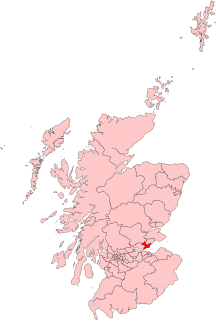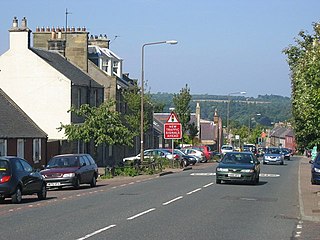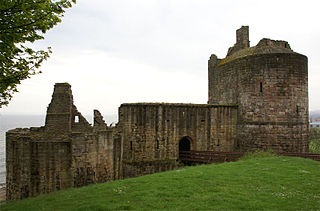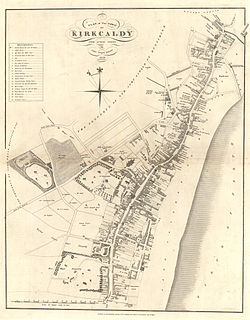
Fife is a council area, historic county, registration county and lieutenancy area of Scotland. It is situated between the Firth of Tay and the Firth of Forth, with inland boundaries with Perth and Kinross and Clackmannanshire. By custom it is widely held to have been one of the major Pictish kingdoms, known as Fib, and is still commonly known as the Kingdom of Fife within Scotland. A person from Fife is known as a Fifer. In older documents the county was very occasionally known by the anglicisation Fifeshire.

Kirkcaldy is a town and former royal burgh in Fife, on the east coast of Scotland. It is about 11.6 miles (19 km) north of Edinburgh and 27.6 miles (44 km) south-southwest of Dundee. The town had a recorded population of 49,460 in 2011, making it Fife's second-largest settlement and the 12th most populous settlement in Scotland.
Forres is a town and former royal burgh in the north of Scotland on the Moray coast, approximately 25 miles (40 km) northeast of Inverness and 12 miles (19 km) west of Elgin. Forres has been a winner of the Scotland in Bloom award on several occasions. There are many geographical and historical attractions nearby such as the River Findhorn, and there are also classical, historical artifacts and monuments within the town itself, such as Forres Tolbooth and Nelson's Tower. Brodie Castle, the home of the Brodie Clan, lies to the west of the town, close to the A96.

Dysart is a former town and royal burgh located on the south-east coast between Kirkcaldy and West Wemyss in Fife. The town is now considered to be a suburb of Kirkcaldy. Dysart was once part of a wider estate owned by the St Clair or Sinclair family. They were responsible for gaining burgh of barony status for the town towards the end of the 15th century.

Kirkcaldy and Cowdenbeath is a county constituency representing the areas around the towns of Kirkcaldy and Cowdenbeath, in Fife, Scotland, in the House of Commons of the Parliament of the United Kingdom. It is currently represented by Alba Party politician Neale Hanvey.

Kirkcaldy was a county constituency of the House of Commons of the Parliament of the United Kingdom in Fife, returning one Member of Parliament (MP). It existed from the February 1974 election until its abolition in 2005.

Kirkcaldy railway station is a railway station in the town of Kirkcaldy, Fife, Scotland. The station is managed by ScotRail and is on the Fife Circle Line and principal East Coast Main Line, 26 miles (42 km) north east of Edinburgh Waverley. British Transport Police maintain a small office on Platform 1.

Robert Blair was a Scottish presbyterian minister who became a Westminster Divine and Moderator of the General Assembly of the Church of Scotland in 1646, after failing to emigrate to Boston in 1636. Born in Irvine in 1593, the sixth son of John Blair of Windyedge, a merchant-adventurer and cadet of Blair, and Beatrix Mure of the Rowallan family, he gained an MA at the University of Glasgow in 1612 and became regent there in 1615. When the episcopalian John Cameron was appointed Principal, Blair resigned and went to Ireland, to become minister of a Presbyterian congregation at Bangor, County Down. He was ordained for it by Robert Echlin, Bishop of Down and Connor, Blair was "very careful to inform... of what accusations had been laid against me of disaffection to the civil powers, whom he was the use of the English liturgy nor Episcopal government.... I declared my opinion fully to the Bishop at our first meeting... [who] said to me, 'I hear good of you, and will impose no conditions on you.'" Echlin, however, turned against him. In September 1631, he was suspended from his ministry and on 4 May 1632 deposed. Though bent on emigrating to New England, the ship in which he and other ministers sailed was driven back by weather, a sign, Blair thought, that his services were still required at home. He dodged an order for his arrest by escaping to Scotland and was admitted to the Second Charge of Ayr in July 1638. After periods in Scotland and Ireland, he accompanied the Scottish army to England in 1640 and helped to negotiate the 1641 Peace of Ripon. In 1646, Blair was elected Moderator of General Assembly, then Chaplain-in-Ordinary to King Charles I. He was also on a committee endeavouring in 1648 to get Cromwell to establish "a uniformity of religion in England." He was summoned to London by Cromwell in 1654, but excused himself on grounds of ill-health. On the establishment of episcopacy he was removed from his charges in September 1661, confined to Musselburgh, then to Kirkcaldy for three and a half years, and then to Meikle Couston, Aberdour, Fife, where he died on 27 August 1666 and was buried.

Pathhead village is a conservation area in Midlothian, Scotland.

Kirkcaldy was a local government district in the Fife region of Scotland from 1975 to 1996, lying a short distance to the south of the regional capital Glenrothes which lay within the district.

Ravenscraig Castle is a ruined castle located in Kirkcaldy which dates from around 1460. The castle is an early example of artillery defence in Scotland.

Kirkcaldy is a former royal burgh and town. Known as one of Scotland's "most ancient burghs", the area surrounding the modern town has a history dating as far back between 2500 BC and 500 BC as a possible funerary landscape.
Oswald is a surname of Scottish, northern English, German and Swiss-German provenance.

James Oswald was a Scottish politician who sat in the House of Commons from 1741 to 1768.

Archibald Campbell Douglas was a Scottish architect based primarily in Glasgow. He designed many churches in Glasgow and Edinburgh, especially those for the Free Church of Scotland.

Path House, formerly known as Dunnikier House, is a manor house in the Scottish town of Kirkcaldy in the Fife Council Area. It was listed by Historic Environment Scotland in 1971 as a Category A listed building.
Thomas Nairn was a controversial Scottish Presbyterian minister. Although he served in several Presbyterian denominations perhaps his most important contribution to church history was his role in setting up the organisation which eventually became the Reformed Presbyterian Church. Although his stay with that religious community was relatively short he was acknowledged, by right of his valid ordination, to have the authority, along with John M'Millan, to form a legitimate presbytery and in so doing to be able to ordain others to the offices of the church. Before Nairn's arrival M'Millan had for more than 36 years been the only minister in what was essentially a small denomination known as the United Societies. Nairn had previously been a minister in the Associate Presbytery of the First Seceders, although he started and ended his days in the Church of Scotland.
Thomas Oswald, younger brother of James Oswald (younger) of Dunnikier, was a British Army officer in 18th century, engaged in the War of the Austrian Succession and Seven Years' War.

David Forbes Smith (1865–1923) was a Scottish architect of many of the Edwardian Baroque civic and co-operative buildings in Fife during the late nineteenth and early twentieth century. Born in Kirkcaldy in 1865 he apprenticed as a carpenter before being articled to John Murray of Kirkcaldy as an architect from 1885 to 1888. He obtained a place in the newly formed partnership of Honeyman & Keppie in Glasgow, overlapping and being photographed in staff pictures with Charles Rennie Mackintosh, and was briefly in the office of Charles Davidson of Paisley before moving to Salisbury as chief assistant to the architect Fred Bath whose office he passed the qualifying exam in 1893. He was admitted as an Associate of the Royal Institute of British Architects on 12 March 1894. In 1898 he returned to his home town, spending the remainder of his career running his own practice until his death on 28 October 1923.

The Boy in the Train is a poem written in Scots, by Mary Campbell (Edgar) Smith (1869-1960), first published in 1913. It is featured in many anthologies of Scottish verse, texts related to railway history, and is routinely quoted when discussing linoleum, and the history of the Scottish town Kirkcaldy. It is a popular poem in Scottish culture, often being a children’s party piece, and "recited by generations of primary school children". The crime-writer Val McDermid, who was born in Kirkcaldy, has said "As school kids we all had to learn The Boy in the Train".















